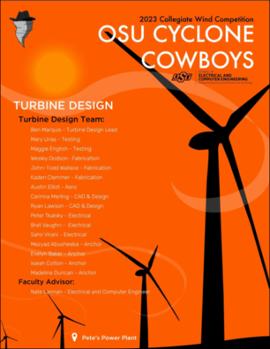| dc.description.abstract | Wind Energy is a leading energy source in Oklahoma, which is a large motivation for the Cyclone Cowboys, being from Oklahoma State University. With this being the first year OSU has competed in the competition, we have researched past projects and produced innovative plans to design a successful wind turbine. To conquer the task of building small scale offshore wind turbine, we have divided the turbine design into 3 sections: Mechanical Systems, Foundation, and Electrical Systems.The Mechanical System includes the blades, a driveline, a braking system, a yaw system, and a nacelle for the turbine. We placed a large emphasis on blade design as blades are a crucial way to impact power generation. The blades were designed and optimized to produce a high RPM at a low cut in speed. Many iterations were fabricated using 3D printing with PLA and tested in a wind tunnel. Our final design features a TSR of 2.5 and is 3D printed with a carbon fiber reinforcement within the PLA to increase its strength. The driveline was designed in two parts: the female driveshaft and the male driveshaft. The male shaft is connected to the nosecone and enters the nacelle through a bearing. The male driveshaft then fits into the collar of the female driveshaft which is meant to support the brake system and mount to the motor. The braking system has two separate components. The first braking component is the brake force from the motor which modulates RPM through the load system. The second braking component is the mechanical disk, which completely stops the driveline when engaged by the servo. Our foundation system is unique due to the shape we designed. A scooping configuration was designed for the anchor, which allows us to enforce the "no excavation rule" while adding durability to the turbine. It has a pole connected to a flat plate on top, which then concaves out on one side to insert the anchor into the sand. The anchor was made by welding a ferrous metal, scrap steel, and weighs 4 lbs. The Electrical System is made up of a generator, a buck boost converter, and a load system. A three-phase brushless motor is used for our generator due to its high efficiency and low friction. A rectifier will be used to convert the AC output to DC. The motor has a kV rating between 100-200 which will increase efficiency while being able to stay under the 48 V constraint. The load system includes an autonomous resistor array, which determines the need to change its resistance value based on input power and voltage calculations through MOSFETs, LCPU, TCPU and UART communication. | |
